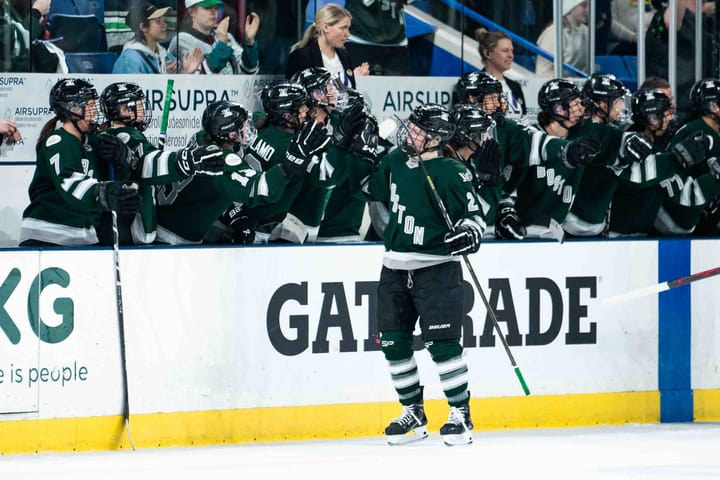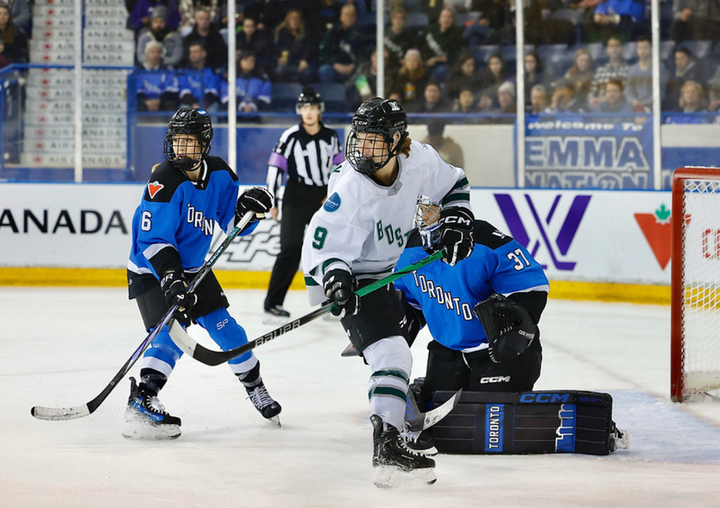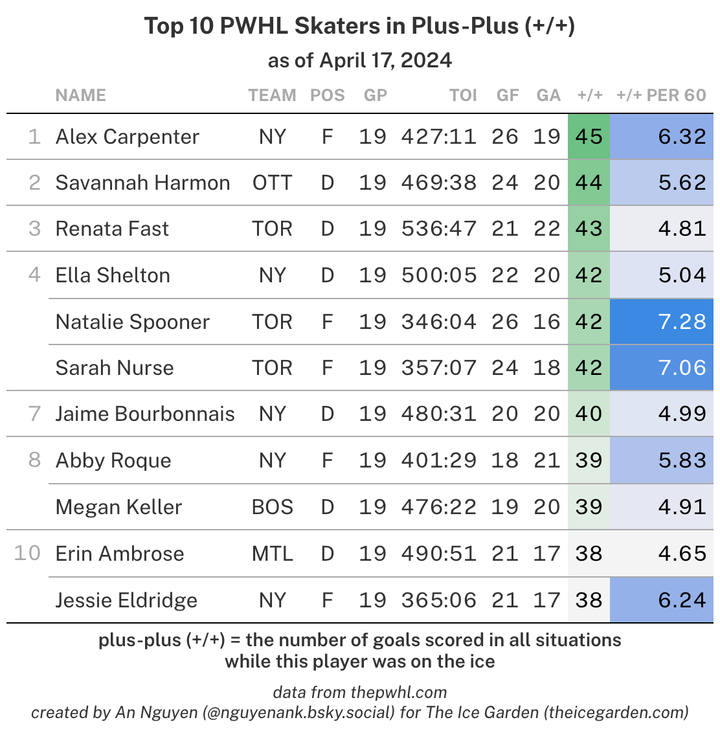The Toronto Six were a dominant possession team in Lake Placid
The Six were a force to be reckoned with at even-strength
Before the 2021 NWHL season began, there was a lot of talk about just how deep the Toronto Six’s forward depth looked on paper. A roster featuring Shiann Darkangelo, Mikyla Grant-Mentis, Brooke Boquist, Breanne Wilson-Bennett, Sarah-Eve Coutu Godbout, and Emma Woods had many convinced that Toronto could challenge even the Boston Pride’s forward depth. We were expecting big things.
As it turns out, the Six’s offense was more consistent than Boston’s — especially at even-strength — in Lake Placid. They were also a more dominant puck possession team, which is something that no one really expected. The Six’s ability to overwhelm opposing teams in the shot share was the key behind their fireworks in the offensive zone in Lake Placid.
Shot Differential
On average, the Toronto Six out-shot the opposition by 15.83 SOG/GP. That is a massive average shot differential, even for a sample of seven games.
It’s important to point out that the Metropolitan Riveters were the only team to defeat Toronto in regulation. The Riveters bested the Six in their first game of the tournament on Jan. 23 by a score of 3-0 — the third goal was an empty-netter scored by Emily Janiga. The Six may have lost that game but they out-shot the Riveters 40-19. That’s a ratio of 2:1. That, my friends, was the sign of a sleeping giant. Teams that out-shoot and out-chance their opponents will generally win more games than they lose.
What’s even more impressive is that Toronto managed to sustain that dominance in shot differential throughout Lake Placid. They out-shot opposing teams by at least 12 shots on goal in all seven of their games. The teams that came closest to matching their furious pace were the Minnesota Whitecaps on Jan. 24 and the Connecticut Whale on Jan. 31.
In years past, shot differential — specifically, shots on goal — and improvised metrics like Steady provided us with a surface-level understanding of possession in the NWHL. But such methods are inherently flawed because they encompass shots (and blocked shots) at all strengths.
The exception was the manual tracking done by Carolyn Wilke back in the NWHL’s inaugural season. Since then, possession has been something of a guessing game for NWHL analysts beyond rare instances of manually-tracked individual games. We have, generally speaking, relied almost exclusively on the eye test, even-strength goal differential, and similar methods to paint a fuzzy picture of possession.
In Lake Placid, we have more data to work with than ever before thanks to InStat and Stathletes. Having access to this data allows us to provide a much richer analysis of possession than ever before.
But with that expansion of data, it can be worth questioning why we’re going back to a metric as simple as shots. Shots — and not just those that reach the net — are super valuable in hockey analysis. Shot attempts, or Corsi, is a foundational concept has been proven to be a better predictor of future scoring than past goal scoring.
Goal scoring is obviously correlated to winning. Teams that score more goals win games, even if they don’t outshoot their opponents. But goal scoring can be streaking, lucky, or influenced by the great equalizer in hockey: goaltending. Plus, there’s only so much scoring in a game or season. That’s even more true in the NWHL, which has a shortened season compared to the NHL. For Lake Placid, our sample is even smaller, lessening the chance of goal scoring giving us the deepest of insights.
Shots aren’t the end all be all, and there can be exceptions because the team that shoots the most doesn’t always win the most, and that’s because shots still don’t show us the entire picture. Shot attempts are just one tool for analysis. But, they’re still an important piece of the puzzle.
Shot Share at Evens
Thanks to data provided by InStat, we can investigate why the Toronto Six finished Lake Placid with the best even-strength goal-differential (+8, excluding empty-net goals) in the league.
A quick look at each team’s average shot attempts for (SF) and against (SA) at even strength reveals that the Six were almost in a class of their own in the shot share. Connecticut averaged more shot attempts at evens than Toronto but they played in three fewer games. They also allowed significantly more shot attempts against at evens. It’s hard to take away much from a four-game sample size.
With that being said, the Whale were still a really impressive team at even strength in Lake Placid. It’s a shame we didn’t get to see more of them this season given the team’s struggles in recent years.
Leading the way for the Six in individual Corsi For — or shot attempts — at evens was Mikyla Grant-Mentis, who we can safely say was one of the best players at driving possession in Lake Placid.
Grant-Mentis averaged 7.0 iCF at even strength per-game. Sarah-Eve Coutu Godbout, who tied with Grant-Mentis to lead all skaters in Lake Placid in shots on goal with 28, averaged 4.3 iCF at evens, but did see significantly less ice time than Grant-Mentis.
All told, Toronto had six players who averaged at least 4.0 iCF at even-strength per-game — Grant-Mentis, Mackenzie MacNeil, Coutu Godbout, Taylor Woods, Lindsay Eastwood, and Wilson-Bennett. The only team in the same neighborhood was the Whale, who had four players averaging at least 4.0 iCF/GP.
Shot Location at Evens
As we explained before, looking at just shots is just one piece of the puzzle. A team can attempt 50 shots without actually creating quality offense. Maybe they are consistently getting the puck off their stick, but are often stuck to the outside. That’s where quality comes into the conversation.
Diving into shot location can take our analysis a step further. It can help reveal a team’s tendencies, whether it’s where they often generate or concede offense. It can also help indicate where a team is failing to create shots, or, in their own zone where they best suppress them.
Looking at the data, it’s clear that Toronto wasn’t just impressive in their shot quantity, but also their shot quality. This is evidenced by Grant-Mentis piling up a team-leading 19 iSCF (individual scoring chances for) at evens, followed closely by Breanne Wilson-Bennett who had 18 iSCF of her own. Only Connecticut’s Janine Weber (3.8) and Alyssa Wohlfeiler (3.3) had a higher iSCF/GP than Grant-Mentis (3.2), and they played fewer games.
EV iSCF/GP leaders in Lake Placid (@InStatHockey)
— Mike Murphy (@DigDeepBSB) February 5, 2021
Weber (CTW) | 3.8
Wohlfeiler (CTW) | 3.3
Grant-Mentis (TOR) | 3.2
Wilson-Bennett (TOR) | 3.0
Thunstrom (MIN) | 2.8
Marcuzzi (TOR) | 2.7
Cornine (MET) | 2.7
Packer (MET) | 2.7
Brand (BOS) | 2.6
*Note: CTW & MIN 4 GP, MET 3 GP
A quick look at Toronto’s shot map at 5v5 also reveals that they attempted a lot of shots inside of the “home plate” area. Unsurprisingly, this is also where the majority of their 5-on-5 goals were scored.
Shot locations can take our analysis a step forward, but still don’t tell the entire story. There have been questions about whether shot location is a better predictor of scoring than shots. In the right context, or in conjunction with other factors, shot locations can be quite handy.
Location, specifically distance and angle, can be a key factor in expected goal models which often also include shot type and whether the attempt was a rush or a rebound. Expected goal models evolved from the simple shot attempt, and some models have tested to be more predictive of scoring than Corsi.
No model is perfect in a sport as chaotic and random as hockey. But blending different ideas and concepts that all stem from a shot can help us better understand players, teams, and situations.
Final Observations
Thinking big picture, Toronto’s dominance of the shot share in Lake Placid was just one of the reasons why there were so impressive. Although goaltender Elaine Chuli had a light workload compared to her peers, facing 25.13 SA60, she dazzled for the Six and finished the tournament with a .936 save percentage. The Six were also solid on special teams with an 18.5 percent success rate on the power play and an 81.5 percent success rate on the penalty kill.
Perhaps the most impressive part of Toronto’s success in Lake Placid was that they were shorthanded at the end of the tournament. Emma Woods, Brooke Boquist, and Kristen Barbara were all “unavailable” and out of the lineup for Toronto’s last two games. Barbara was also out of the lineup on Jan. 27 against the Beauts.
These were big-time players missing from the Six’s lineup. Barbara was billed as one of Toronto’s best defenders before Lake Placid; Woods had four assists in her first four games and was averaging 5.5 SOG/GP; Boquist had four primary points in her first four games.
Yet despite those absences, the Six only seemed to get better with each passing game in Lake Placid. After a disappointing loss to the Riveters and letting a 5-1 lead over the Whitecaps slip through their hands in their first two games they were a buzzsaw.
Toronto president and head coach Digit Murphy has said repeatedly that she isn’t a big x’s and o’s kind of coach. She also said that each player on Toronto was hand-picked for their character and ability. Clearly, the Six did an exceptional job recruiting talent for their first season. They were the first seed heading into the Isobel Cup Semifinals because they were a deep team with great goaltending that was dominant in possession.
Data courtesy of InStat and HerHockeyCounts.com.





Comments ()